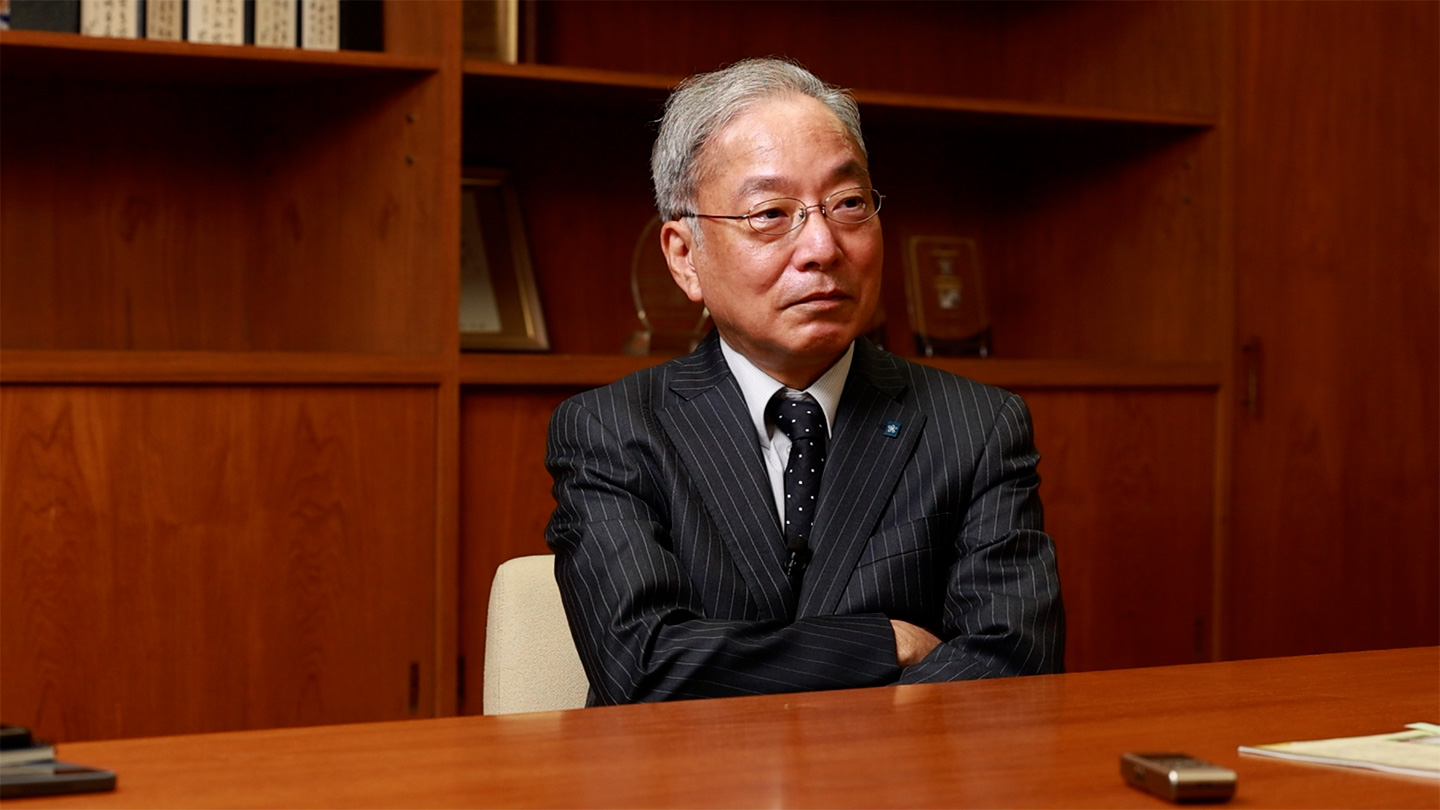Survey or Interview西尾 和人
近畿大学の活力は臨床研究
患者のための研究をこれからも
With clinical research at its core— Kindai University advances patient-focused discoveries for the future.
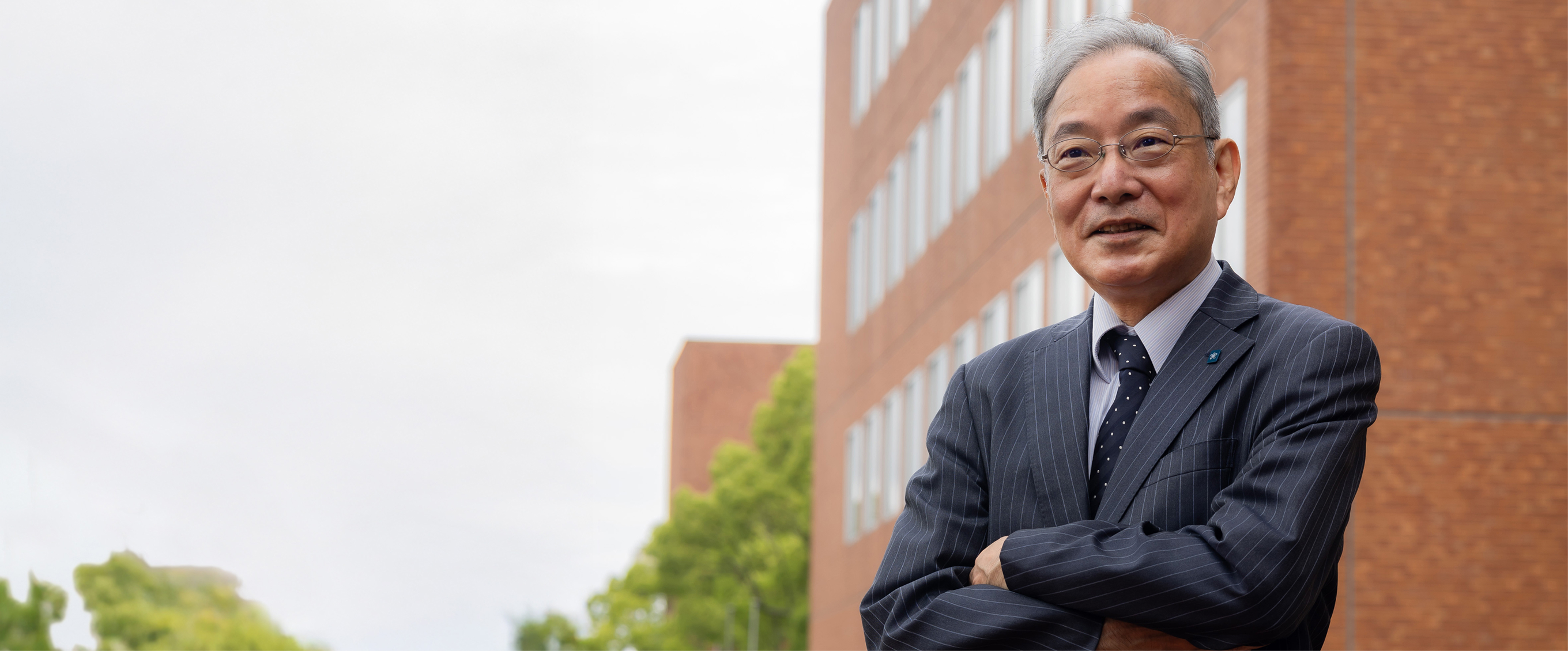
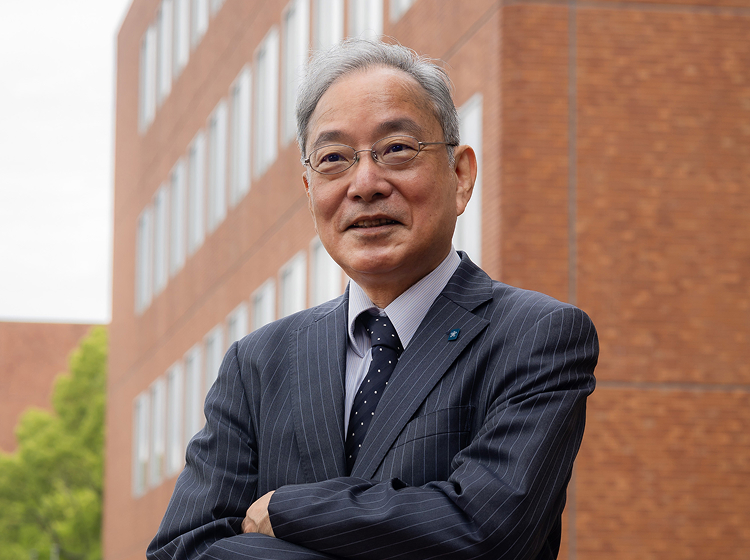
西尾 和人
Interview
NISHIO Kazuto
医学部長
Dean, Faculty of Medicine
西尾和人が近畿大学医学部ゲノム生物学講座教授に就任したのは2006年のことだ。「ゲノム生物学」とは、DNAレベルで遺伝子を解析し、病気の原因や新しい治療法を探る分子生物学の一分野である。
前所属である国立がんセンターで、西尾が取り組んでいた研究の1つは「シスプラチン」という抗がん剤の耐性を調べることだった。シスプラチンは精巣がん、卵巣がん、膀胱がんなどに幅広く使用されている薬剤である。シスプラチンに限らず、抗がん剤を投与し続けると、がんは対応し、〝耐性〟を持つようになる。
「ぼくがやっていたのは、〝シグナル伝達〟の研究。当時はニッチな研究でした」
シグナル伝達とは、がん細胞が増殖・生存・浸潤・転移するために利用する細胞内外の情報伝達経路の意だ。当時は研究している人はほとんどいなかったという。
そんな西尾の研究に光が当たることになったのは、分子標的薬の登場だった。
分子標的治療薬は、がん化やがん細胞の増殖に関わるタンパク質、酵素の分子などに「標的」を絞って、その働きを抑える。西尾の専門であるシグナル伝達に引き寄せるならば、がん細胞が異常に活性化しているシグナル伝達経路の“鍵となる分子”を分子標的治療薬は、狙い撃ちし、その情報伝達経路を遮断。つまりがんを縮小する。
その嚆矢が、ゼネカ(現・アストロゼネカ)社の『ゲフィチニブ(商品名イレッサ』である。
ゲフィチニブはEGFR阻害薬(上皮成長因子受容体阻害薬:Epidermal Growth Factor Receptor-Tyrosine Kinase Inhibitor, EGFR-TKI)の1つだ。EGFRとは細胞の増殖に関わるタンパク質である。このEGFR遺伝子に変異があると、ゲフィチニブが効く。
「ゲフィチニブは効くときはものすごく効くが、必ず耐性になる。ゲフィチニブの耐性株を作って、なぜ耐性があるのか、そのメカニズムを調べていました」
ニッチな研究が、時代の最先端になったのだ。
ゲフィチニブは2002年に「切除不能な進行・再発の非小細胞肺癌」への効果があるとして世界に先駆けて日本で承認されている。
「世界で初めて、このイレッサの臨床研究を行なっていたのが近畿大学のグループだったんです」
こうした新薬の治験が近畿大学で行われていたのは、がんの臨床試験に精通した研究グループ(第4内科)があったからだ。同グループは日本で初期に設置された本格的な「腫瘍内科」となる。腫瘍内科は、臓器の枠を超えて、横断的にがんを扱う。
「近畿大学の福岡正博先生や中川和彦先生は『WJOG(West Japan Oncology Group)』という多施設共同の臨床試験グループでEGFRに関する研究を一緒にやってきていました」
こうした縁が西尾を近畿大学に引き寄せたのだ。
前所属である国立がんセンターで、西尾が取り組んでいた研究の1つは「シスプラチン」という抗がん剤の耐性を調べることだった。シスプラチンは精巣がん、卵巣がん、膀胱がんなどに幅広く使用されている薬剤である。シスプラチンに限らず、抗がん剤を投与し続けると、がんは対応し、〝耐性〟を持つようになる。
「ぼくがやっていたのは、〝シグナル伝達〟の研究。当時はニッチな研究でした」
シグナル伝達とは、がん細胞が増殖・生存・浸潤・転移するために利用する細胞内外の情報伝達経路の意だ。当時は研究している人はほとんどいなかったという。
そんな西尾の研究に光が当たることになったのは、分子標的薬の登場だった。
分子標的治療薬は、がん化やがん細胞の増殖に関わるタンパク質、酵素の分子などに「標的」を絞って、その働きを抑える。西尾の専門であるシグナル伝達に引き寄せるならば、がん細胞が異常に活性化しているシグナル伝達経路の“鍵となる分子”を分子標的治療薬は、狙い撃ちし、その情報伝達経路を遮断。つまりがんを縮小する。
その嚆矢が、ゼネカ(現・アストロゼネカ)社の『ゲフィチニブ(商品名イレッサ』である。
ゲフィチニブはEGFR阻害薬(上皮成長因子受容体阻害薬:Epidermal Growth Factor Receptor-Tyrosine Kinase Inhibitor, EGFR-TKI)の1つだ。EGFRとは細胞の増殖に関わるタンパク質である。このEGFR遺伝子に変異があると、ゲフィチニブが効く。
「ゲフィチニブは効くときはものすごく効くが、必ず耐性になる。ゲフィチニブの耐性株を作って、なぜ耐性があるのか、そのメカニズムを調べていました」
ニッチな研究が、時代の最先端になったのだ。
ゲフィチニブは2002年に「切除不能な進行・再発の非小細胞肺癌」への効果があるとして世界に先駆けて日本で承認されている。
「世界で初めて、このイレッサの臨床研究を行なっていたのが近畿大学のグループだったんです」
こうした新薬の治験が近畿大学で行われていたのは、がんの臨床試験に精通した研究グループ(第4内科)があったからだ。同グループは日本で初期に設置された本格的な「腫瘍内科」となる。腫瘍内科は、臓器の枠を超えて、横断的にがんを扱う。
「近畿大学の福岡正博先生や中川和彦先生は『WJOG(West Japan Oncology Group)』という多施設共同の臨床試験グループでEGFRに関する研究を一緒にやってきていました」
こうした縁が西尾を近畿大学に引き寄せたのだ。
All for the sake of the patients — mastering ‘basic medicine’ to connect it to clinical practice.
NISHIO Kazuto was appointed professor of the Department of Genome Biology at Kindai University Faculty of Medicine in 2006.“Genome biology,” is a field of molecular biology that analyzes genes at the DNA level to uncover the causes of disease and to develop new therapies.
At his previous post at the National Cancer Center, NISHIO had devoted himself to one line of research in particular: that of investigating resistance to the anticancer drug cisplatin. Cisplatin is widely used in the treatment of testicular cancer, ovarian cancer, bladder cancer, and more. But like so many anticancer agents, cisplatin becomes less effective over time as cancer cells adapt and develop “resistance.”
“What I was studying then was signal transduction,” he recalls. “At the time, it was considered a niche area of research.”
Signal transduction refers to the intricate pathways of information transfer within and between cells, pathways that cancer cells hijack to proliferate, survive, invade, and metastasize. Few researchers were working in the field then. But NISHIO’s work took on new importance with the advent of molecularly targeted therapies.
These drugs act by pinpointing proteins and enzymes that drive cancer development and cell growth, shutting down the specific pathways that allow tumors to thrive. Applied to NISHIO’s field, molecularly targeted therapies block the “key molecules” in abnormally activated signal transduction pathways, thereby suppressing cancer growth.
The pioneer among them was gefitinib (marketed as Iressa), developed from AstraZeneca. Gefitinib belongs to a class known as EGFR inhibitors (Epidermal Growth Factor Receptor–Tyrosine Kinase Inhibitors, EGFR-TKIs). EGFR itself is a protein involved in cell growth, and mutations in the EGFR gene determine whether gefitinib is effective.
“When gefitinib works, it works astonishingly well—but resistance always develops. I created gefitinib-resistant cell lines and studied the mechanisms behind that resistance,” NISHIO recalls.
What had once been a niche line of inquiry had become the cutting edge of oncology. In 2002, gefitinib was approved in Japan ahead of the rest of the world for use in patients with “unresectable advanced or recurrent non–small cell lung cancer.”
“The very first clinical research on Iressa anywhere in the world was being carried out by the group at Kindai University Faculty of Medicine,” he says with pride.
It was no coincidence that these early trials of new drugs were conducted at Kindai University. The university’s Fourth Department of Internal Medicine had developed into one of Japan’s first full-fledged Departments of Medical Oncology, organized to treat cancers across organs rather than within a single specialty.
“Kindai Professors FUKUOKA Masahiro and NAKAGAWA Kazuhiko had already been conducting collaborative research on EGFR through the West Japan Oncology Group (WJOG), a multi-institutional clinical trial network,” NISHIO explains.
These professional ties and the university’s pioneering role in clinical oncology research ultimately drew NISHIO to Kindai University.
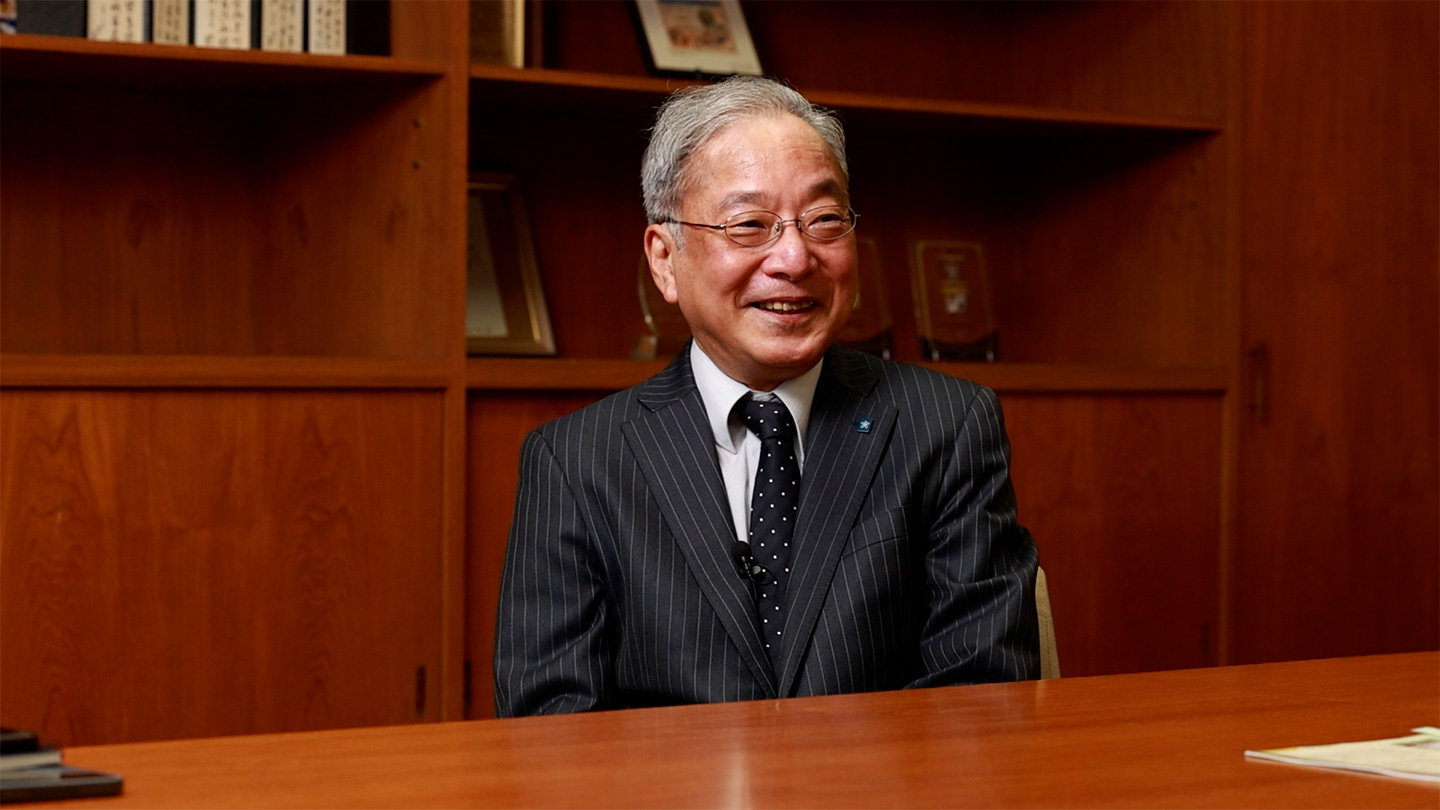
西尾は1961年に生まれた。一家は和歌山から大阪に移ったため、大阪育ちである。
「小児喘息があって、病院にはずっと通っていたので身近な存在でした。小学校4年のときには、救急車で運ばれたこともあります。だから、呼吸器にはずっと関心があったんです」
医学部を選んだのは消去法だったのだと頭をかく。
「生物が好きで理学部生物科に行きたかったんです。父親に相談すると、就職が難しいんじゃないかと。親戚に和歌山医科大学卒業の医師がいて、生物やりたいならば医学部でいいんじゃないかと言われました」
和歌山県立医科大学医学部ではヨット部に入り、全日本選手権にも出場した。大学生のときはもう真っ黒でした。サーファーみたいだと言われていました。でも、ぼくは泳げないというオチがつく、と笑う。大学卒業後は、和歌山県立医科大学附属病院に入局し、和歌山県の内陸部、伊都郡かつらぎ町の紀北分院に勤務した。内科医を志したのだ。
「自分がかつて喘息だったというのもありました。呼吸器(内科)、特に結核の化学療法の治療体系は論理的なんです。そこに惹かれました。当時、和歌山(県立)医大では呼吸器内科がなかったので、結核病棟がある紀北分院で勉強することにしました」
人口約2万人という伊都郡で西尾は僻地医療の現状と向き合うことになった。
「結核や肺がんなどが末期になるまで放っておかれていた。山の奥から2時間かけて軽トラックの荷台に喘息の子どもが乗せられてきたこともありました。本当に医療が届きにくい地域なんだと実感しました」
どのようにすればより良い医療を届けることができるかという思いで奮闘しているとき、前出の「シスプラチン」という肺がんに対する抗がん剤が登場した。この薬は服用時、点滴で大量の水分を一緒に投与——ハイドレーションしなければ、腎臓の機能が低下、時に命にかかわる状態に陥る。
「当時、その知識や技術が十分に浸透していませんでした。このままではいけないと思い、シスプラチンの正しいハイドレーションの方法を学ぶため、国立がんセンターに行くことを決めたんです」
国立がんセンター研究所は当初2週間の滞在予定だった。しかし、結局、がんセンターにそのまま居着くことになった。年代が近く、同じ研究に没頭する仲間との日々は楽しいものだった。
「がんセンターでは研究とゲームの日々でした」とおかしそうに笑う。研究が終わると、研究室に集まってみんなでゲームをする。当時はインターネットに接続するゲームはなかったため、同時刻にスタートして競うのだ。
「当時のメンバーには、人生の中で一番面白かったのは、幼稚園のときとがんセンターの3年間だと言う人もいる。みんなそんな思いでしたね」
こうして西尾は基礎研究の道を突き進み、近畿大学にやってきたのだ。
「小児喘息があって、病院にはずっと通っていたので身近な存在でした。小学校4年のときには、救急車で運ばれたこともあります。だから、呼吸器にはずっと関心があったんです」
医学部を選んだのは消去法だったのだと頭をかく。
「生物が好きで理学部生物科に行きたかったんです。父親に相談すると、就職が難しいんじゃないかと。親戚に和歌山医科大学卒業の医師がいて、生物やりたいならば医学部でいいんじゃないかと言われました」
和歌山県立医科大学医学部ではヨット部に入り、全日本選手権にも出場した。大学生のときはもう真っ黒でした。サーファーみたいだと言われていました。でも、ぼくは泳げないというオチがつく、と笑う。大学卒業後は、和歌山県立医科大学附属病院に入局し、和歌山県の内陸部、伊都郡かつらぎ町の紀北分院に勤務した。内科医を志したのだ。
「自分がかつて喘息だったというのもありました。呼吸器(内科)、特に結核の化学療法の治療体系は論理的なんです。そこに惹かれました。当時、和歌山(県立)医大では呼吸器内科がなかったので、結核病棟がある紀北分院で勉強することにしました」
人口約2万人という伊都郡で西尾は僻地医療の現状と向き合うことになった。
「結核や肺がんなどが末期になるまで放っておかれていた。山の奥から2時間かけて軽トラックの荷台に喘息の子どもが乗せられてきたこともありました。本当に医療が届きにくい地域なんだと実感しました」
どのようにすればより良い医療を届けることができるかという思いで奮闘しているとき、前出の「シスプラチン」という肺がんに対する抗がん剤が登場した。この薬は服用時、点滴で大量の水分を一緒に投与——ハイドレーションしなければ、腎臓の機能が低下、時に命にかかわる状態に陥る。
「当時、その知識や技術が十分に浸透していませんでした。このままではいけないと思い、シスプラチンの正しいハイドレーションの方法を学ぶため、国立がんセンターに行くことを決めたんです」
国立がんセンター研究所は当初2週間の滞在予定だった。しかし、結局、がんセンターにそのまま居着くことになった。年代が近く、同じ研究に没頭する仲間との日々は楽しいものだった。
「がんセンターでは研究とゲームの日々でした」とおかしそうに笑う。研究が終わると、研究室に集まってみんなでゲームをする。当時はインターネットに接続するゲームはなかったため、同時刻にスタートして競うのだ。
「当時のメンバーには、人生の中で一番面白かったのは、幼稚園のときとがんセンターの3年間だと言う人もいる。みんなそんな思いでしたね」
こうして西尾は基礎研究の道を突き進み、近畿大学にやってきたのだ。
With the desire to deliver better healthcare to remote areas, I went to the Cancer Center.
NISHIO was born in 1961. Though his family had roots in Wakayama, they moved to Osaka, and he grew up there.“I had childhood asthma and was always going to the hospital, so medicine was familiar to me from an early age. When I was in the fourth grade, I was even rushed there in an ambulance. That’s why I’ve always had an interest in the respiratory system,” he recalls.
He admits that his choice of medicine came through a process of elimination.
“I really liked biology and wanted to study it in the Faculty of Science. But when I consulted my father, he told me it might be difficult to find a job. One of my relatives had graduated from Wakayama Medical University and became a doctor, and he told me, ‘If you want to pursue biology, why not enter medical school instead?’”
At Wakayama Medical University, NISHIO joined the yacht club and even competed in the All-Japan Championships. “During my student days, I was completely tanned. People used to say I looked like a surfer. But the funny thing is, I actually can’t swim,” he says with a smile.
After graduating, he entered the university hospital and was assigned to the Kihoku Branch Hospital in Katsuragi Town, an inland region of Wakayama Prefecture, where he set out to become an internist.
“Because I had asthma myself, I was naturally interested in respiratory medicine. What attracted me most was the logical structure of chemotherapy for tuberculosis. At that time, Wakayama Medical University didn’t even have a dedicated department of respiratory medicine, so I decided to study at the Kihoku Branch, which had a tuberculosis ward.”
In this rural area of only about 20,000 people, NISHIO came face-to-face with the realities of rural medicine.
“Patients with tuberculosis or lung cancer were often left untreated until the disease had reached its final stages. I remember one time when a child with asthma was brought from deep in the mountains, two hours away, riding in the back of a small truck. That was when I truly realized how difficult it was for healthcare to reach some communities,” he recalls.
As NISHIO struggled with the question of how to deliver better medical care, a new anticancer drug for lung cancer—cisplatin—was introduced. This drug required patients to receive simultaneous intravenous infusion of large volumes of fluid—a process known as hydration—to protect kidney function. Without proper hydration, patients risked serious, even life-threatening, renal impairment.
“At that time, the knowledge and techniques for safe hydration with cisplatin weren’t yet widely understood. I felt strongly that something had to be done, so I decided to go to the National Cancer Center to learn the correct methods of cisplatin hydration,” he recalls.
Originally, he had planned to stay at the National Cancer Center Research Institute for just two weeks. But in the end, he never left. Surrounded by peers of his own generation, all equally absorbed in research, he found the environment stimulating and the work deeply rewarding.
“At the Cancer Center, it was research by day and games by night,” he recalls with a laugh. When their experiments ended, everyone would gather in the lab to play games. Since online gaming didn’t exist yet, they would all start at the same time and compete head-to-head. One of my colleagues used to say that the most enjoyable times of his life were kindergarten and those three years at the Cancer Center. That’s how everyone felt,” NISHIO recalls fondly.
Those years set NISHIO firmly on the path of basic research—one that would eventually lead him to Kindai University Faculty of Medicine.
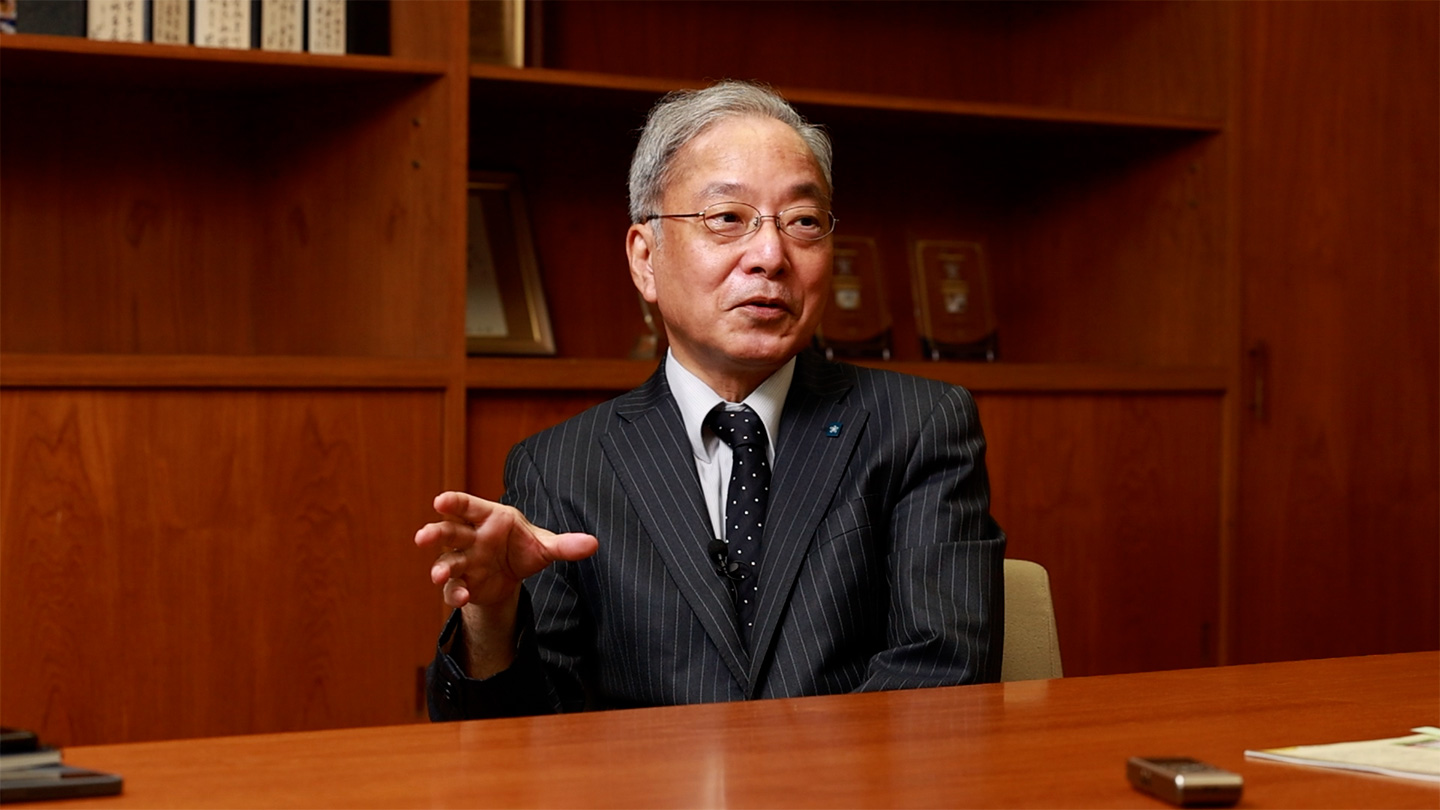
近畿大学の良さは、特に腫瘍内科の分野において、患者を治療する「臨床」と「基礎研究」を並行して行う文化があることだと西尾は言う。
「大学によっては臨床と基礎の研究室が別棟ということもあります。近畿大学の場合は、臨床と基礎が隣り合わせの教室もある。垣根が低いんです。トランスレーショナルリサーチを実践する土壌がある」
トランスレーショナルリサーチとは、基礎研究で得られた成果を、実際の臨床応用、つまり医療現場での診断・治療・予防につなげるための「橋渡し研究」を意味する。
「(医学部卒業後)臨床研修終わってからうちの研究室に若い医師が来ます。研究者としては何も知らない〝ベイビー〟です。しかし、そこから2、3年でぐっと伸びる。なぜかというと、患者さんを知っているからです。研究を臨床の現場に持ち帰って、患者さんのためになりたいというモチベーションがある。クリニカルクエスチョンがある」
医療現場で患者と向き合う中で生まれる診療上の疑問と課題——これがクリニカルクエスチョンである。目の前の患者を救いたいという思いが、研究の推進力になる。かつての西尾と同じだ。
今も西尾の根底には患者のため、という考えがある。
その1つの例が、次世代シーケンサー(NGS)による遺伝子パネル検査の導入だ。
2000年代初め、西尾たちの研究の積み重ねにより、イレッサが特定の遺伝子変異に有効であることが判明。ここで重要になるのが膨大な遺伝子データの解析である。NGSは、DNAやRNAの配列(遺伝子情報)を大量かつ高速に読み取る。そのため、可能性の低い遺伝子変異まで検査を範囲を広げることが可能だ。
「当時は1検体200万円と高額でしたが、クラウドファンディングなどで患者さんの負担軽減にも取り組みました。同時に厚生労働省に保険適用するよう働きかけました」
現在、遺伝子パネル検査は保険適用され、多くの患者の力となっている。
今の職業を天職に思ったのはいつですか、と尋ねた。西尾は首をひねって少し考えたあと、こう返した。
「国立がんセンターのときにリサーチレジデントからスタッフにならないかという話をもらったんです」
リサーチレジデントとは基礎医学や臨床研究にも取り組む特別な研修生のことだ。
「そのときすごく悩みました。がんセンターには全国から優秀な人が集まっている。そこで研究者としてずっとやっていけることができるのか。患者さんを診るのも好きでした。臨床医としてやっていきたいという気持ちもありました。最終的には研究やってて面白いと思ったんです。天職って、やっていて楽しいことじゃないですか。のめり込むことができることって天職になると思うんです」
2023年、西尾は近畿大学医学部の医学部長に就任した。基礎研究出身者としては、歴代で3人目となる。
「仕事としては教育、そしてアドミニストレーション(経営)的な管理業務が増えました。近畿大学の活力は臨床研究。今後の方向性をきちんと示しておくという意味で責任を感じています」
残念なのは、研究の時間が取れなくなることですと冗談めかして笑う。それでも若い学生・大学院生が楽しく研究をしている姿を見るのが今の楽しみですと付け加えた。
「大学によっては臨床と基礎の研究室が別棟ということもあります。近畿大学の場合は、臨床と基礎が隣り合わせの教室もある。垣根が低いんです。トランスレーショナルリサーチを実践する土壌がある」
トランスレーショナルリサーチとは、基礎研究で得られた成果を、実際の臨床応用、つまり医療現場での診断・治療・予防につなげるための「橋渡し研究」を意味する。
「(医学部卒業後)臨床研修終わってからうちの研究室に若い医師が来ます。研究者としては何も知らない〝ベイビー〟です。しかし、そこから2、3年でぐっと伸びる。なぜかというと、患者さんを知っているからです。研究を臨床の現場に持ち帰って、患者さんのためになりたいというモチベーションがある。クリニカルクエスチョンがある」
医療現場で患者と向き合う中で生まれる診療上の疑問と課題——これがクリニカルクエスチョンである。目の前の患者を救いたいという思いが、研究の推進力になる。かつての西尾と同じだ。
今も西尾の根底には患者のため、という考えがある。
その1つの例が、次世代シーケンサー(NGS)による遺伝子パネル検査の導入だ。
2000年代初め、西尾たちの研究の積み重ねにより、イレッサが特定の遺伝子変異に有効であることが判明。ここで重要になるのが膨大な遺伝子データの解析である。NGSは、DNAやRNAの配列(遺伝子情報)を大量かつ高速に読み取る。そのため、可能性の低い遺伝子変異まで検査を範囲を広げることが可能だ。
「当時は1検体200万円と高額でしたが、クラウドファンディングなどで患者さんの負担軽減にも取り組みました。同時に厚生労働省に保険適用するよう働きかけました」
現在、遺伝子パネル検査は保険適用され、多くの患者の力となっている。
今の職業を天職に思ったのはいつですか、と尋ねた。西尾は首をひねって少し考えたあと、こう返した。
「国立がんセンターのときにリサーチレジデントからスタッフにならないかという話をもらったんです」
リサーチレジデントとは基礎医学や臨床研究にも取り組む特別な研修生のことだ。
「そのときすごく悩みました。がんセンターには全国から優秀な人が集まっている。そこで研究者としてずっとやっていけることができるのか。患者さんを診るのも好きでした。臨床医としてやっていきたいという気持ちもありました。最終的には研究やってて面白いと思ったんです。天職って、やっていて楽しいことじゃないですか。のめり込むことができることって天職になると思うんです」
2023年、西尾は近畿大学医学部の医学部長に就任した。基礎研究出身者としては、歴代で3人目となる。
「仕事としては教育、そしてアドミニストレーション(経営)的な管理業務が増えました。近畿大学の活力は臨床研究。今後の方向性をきちんと示しておくという意味で責任を感じています」
残念なのは、研究の時間が取れなくなることですと冗談めかして笑う。それでも若い学生・大学院生が楽しく研究をしている姿を見るのが今の楽しみですと付け加えた。
Clinical questions — the drive to save the patient right in front of you becomes the engine of research.
NISHIO says that what makes Kindai University truly special—particularly in the field of medical oncology—is its culture of pursuing both “clinical practice” and “basic research” side by side.“At some universities, the clinical and basic research labs are even housed in separate buildings. At Kindai, they are often next door to each other. There’s an environment here that naturally fosters translational research,” he explains.
Translational research refers to “bridging research”— the process of taking discoveries from basic science and applying them directly to clinical practice, whether in diagnosis, treatment, or prevention.
“After completing their clinical training, young doctors often come to our lab. As researchers, they start out knowing almost nothing—they’re like babies. But in two or three years, they grow remarkably. Why? Because they know patients. They bring their research back to the clinical setting with a motivation to help their patients. They have real clinical questions driving them,” NISHIO says.
Those “clinical questions” arise directly from the doubts and challenges doctors encounter while treating patients at the bedside. The desire to save the patient in front of them becomes the driving force of research—just as it once did for NISHIO himself.
At the core of NISHIO’s work today remains the same conviction: everything must be for the sake of the patient. One example was his role in introducing gene panel testing using next-generation sequencing (NGS).
In the early 2000s, through years of research, NISHIO and his colleagues had revealed that Iressa (gefitinib) was effective against cancers carrying specific genetic mutations. This breakthrough made large-scale genetic data analysis essential. NGS technology allows for the massive, high-speed reading of DNA and RNA sequences, enabling testing to be expanded even to mutations previously thought unlikely.
“At that time, each test cost around two million yen, which was prohibitively expensive,” NISHIO recalls. “We tried to ease the burden on patients through crowdfunding, while also lobbying the Ministry of Health, Labour and Welfare to secure insurance coverage.”
Today, genetic panel testing is covered by health insurance and has become a vital tool for many patients.
When asked when he first came to feel that his profession was truly his “calling,” NISHIO tilted his head, thought for a moment, and then answered:
“It was when I was at the National Cancer Center and was invited to move from being a research resident to becoming a staff member,” he recalls. A research resident is a special trainee engaged in both basic science and clinical research. “I agonized over it. The Cancer Center attracted the brightest people from all over Japan. Could I really hold my own there as a researcher? At the same time, I loved treating patients. I wanted to continue as a clinician as well. In the end, what swayed me was simply that I found research fun. Isn’t that what a vocation is? Something that you can throw yourself into, completely absorbed—that becomes your calling.”
In 2023, NISHIO was appointed Dean of Kindai University Faculty of Medicine, becoming only the third dean in its history to come from a background in basic research.
“My work now involves education, as well as more administrative and managerial duties. The strength of Kindai University lies in its clinical research, and I feel a responsibility to clearly set the course for its future direction,” he says.
With a wry smile, he admits the one regret is that he no longer has enough time for his own research. Yet he quickly adds that his greatest pleasure now is seeing young students and graduate students enjoying research and throwing themselves into discovery, just as he once did.
